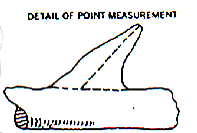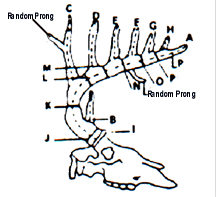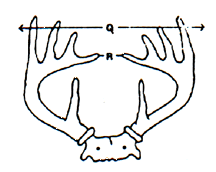Deer
Additional InformationNote #1
All measurements to be in inches to the nearest eighth.
Note #2
No protuberance to be counted as a point or as a random prong unless it is at least one inch in length from tip of point to outside of main beam. If the main beam is irregular at that spot, the outside of the main beam is considered to be the projected line of the principal curve of the beam, see Detail “A.” Protuberances less than an inch in length are to be ignored.
Note #3
Length of points to be measured on their outside centerline from tip of point to outside centerline from tip of point to outside edge of main beam, see Detail “A”, and measurements “B”, “C”, “D”, “E”, “F”, “G”, and “H”. Points are those protuberances an inch or more in length which spring regularly and in sequence from the main beam in the typical whitetail deer antler pattern.

Note #4
Any protuberance which meets the requirements of Note 2 for length but which does not meet the Note 3 requirement of being a main pattern point shall be classed as a random prong. If there exist any doubt in the mind of the scorer as to whether or not a protuberance is a main pattern point, it shall be scored as a random prong. The length of random prongs is measured in the same manner as for points, see Note 3.
Note #5
Circumference of beam to be taken at smallest section between points, see measurements “K”, “L”, “M”, “N”, “O”, and “P”. No circumference measurements to be taken between last point and tip of main beam. In taking measurements “I”, and “J”, all projecting prongs and protuberances on burr and main beams shall be ignored so far as practicable.

Note #6
Measurement “Q” covers outside spread of main beams and projecting points should be ignored. However, since the antler tips are considered as part of the main beam, measurement “R” on a wide flaring type of antler may be the same for tip to tip and for outside spread of beam.

Note #7
The right antler is the antler on the right side of the deer.
Note #8
Measurement “R”, tip to tip spread, is not a scoring measurement. It is used to determine the bonus awarded to heads whose beams curve inward in the typical whitetail pattern, the reason being to protect them against competition from freakish heads whose beams flare straight out. This score is a bonus score only, and no score is entered if “R” exceeds “Q.”

Note #9
Penalties are charged for non-symmetry, random prongs, and excess spread. Since random prongs are obviously less important than main pattern points of corresponding length, the random prong penalty results in such prongs being given only half-credit for their length. The excess spread penalty is a further protection against freak heads, in addition to the bonus mentioned in Note 8, and there will be not penalty assessed in this column except in the rare cases where spread exceeds the average length of the main beams.
Note #10
In counting the total number of points and random prongs, each beam tip counts as a point.
Score Your Deer
If you would like to score your own trophy, follow the notes found on this page and the score sheet provided below. This will give you an approximate overall score. If you want to have your trophy officially scored by the VPSA, you must attend and participate in the Annual Virginia Big Game Contest.
Scoring Other Trophies
How to Score your Turkey
Official turkey scoring rules used at the VPSA Big Game Contest
How To Score Your Bear
Official bear scoring rules used at the VPSA Big Game Contest
